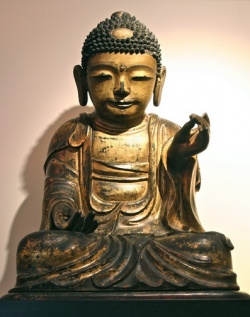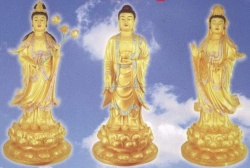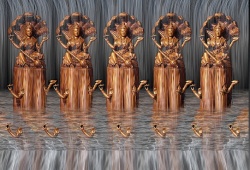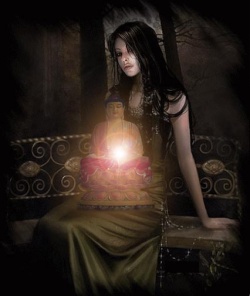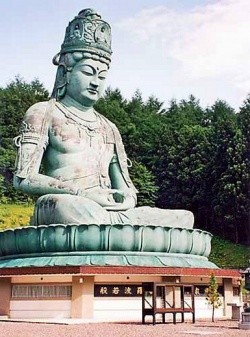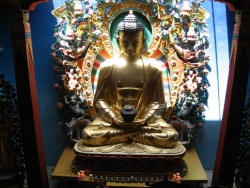Bowing to the Buddha
The Buddhist practice of bowing to the Buddha diminishes one's habits of self-importance, pride, and arrogance. It is also a good physical exercise that can make the body strong.
Bowing in Buddhism cuts across the lines of traditions and schools. Bowing has been part of Buddhist practice since the Buddha’s time in India and continues to this day. Within the Buddhist Sangha, or monastic community, the daily liturgical schedule began and ended with dozens if not hundreds of ritual prostrations.
On ceremony days, clergy and laity alike might engage in the practice of liturgical repentance and bow up to ten thousand times. Monks and nuns bow to the images of Sages, Awakened Beings, and the Buddhas, to their superiors, and to each other.
Bowing to the Buddha is like Bowing to the Buddha Within, it is more than a simple gesture; a bow is an act of veneration -- for us and for all.
Venerable Shi Yong He
Bowing is an important practice in Buddhism. It involves a full prostration-the placing of the forehead, forearms, and knees on the ground in a total gesture of reverence and of worship.
It is usually done before an image of the Buddha, a Bodhisattva, a sage, or before a holy text.
It is a misconception, though, to think that the worshipper is bowing to a statue of the Buddha, to a wooden or stone or clay image.
The Buddha we bow to is the Buddha inside our true minds, the pure good and perfect spiritual nature that has no shape or form. Images of the Buddha are simply symbols of the real thing. Bowing is a mindfulness practice.
Venerable Shi Yong Po
Buddhist scripture tells us that the Buddha realized his great awakening while sitting beneath a tree in the wilderness of northern India at Bodh Gaya. According to the sutras, when he awoke on that auspicious day, the entire natural world bowed to him in gladness, recognition, and veneration.
The earth trembled, and trees, flowers, and tall blades of elephant grass bent down in respect.
We join in reverence and enter into that moment each time we bow.
Mahayana Buddhist Monks like Shaolin Monks bow from morning to night.
Bowing opens and closes every one of the three daily ceremonies. Each ceremony requires a minimum of nine bows.
Interviews and meetings with teachers, superiors, depending on respective rank, require from one to three full prostrations, each set of three prostrations followed by a half-bow.
Chan students perform half bows to the altar, to each other and to the cushion before and after meditation.
Chan practitioners offer large numbers of full bows to the Three Jewels; the Buddha the dharma and the Sangha in their meditation centers and monasteries.
Many Chan teachers used to offer 108 bows each morning before the large Buddha statue on the altar of their temple, even at an advanced age.
And in all Buddhist traditions, three bows are offered when entering the presence of spiritual masters and teachers, acknowledging the presence of an embodiment of the principle of enlightenment.
Novice monks in training bow hundreds of times each day, to mold the new “habitus” of monk’s deportment, to assist the transition of identity from lay-person to Sangha member.
The canonical texts describe venerable Bodhisattvas of great accomplishment bowing to the ground before the Buddha.
The Youth Sudhana, in the Gandhavyuha chapter of the Avatamsaka Sutra, who is the archetype of the bowing pilgrim, bows to 53 teachers.
Over and over he prostrates his five limbs (hands, feet and head) low to the ground to purge arrogance, repent of past offences, demonstrate respect, and ultimately, to realize the highest goals of a Bodhisattva’s wisdom and compassion.
Seven Ways to Bow
There are seven different ways that people bow to the Buddha:
1) The first is 'arrogant bowing', and describes a person who, although he or she bows to the Buddha, still has a mark of a self.
2) The second kind of bowing is called 'seeking for fame'. This category describes one who hears others praising a cultivator saying, 'That person bows often and really cultivates vigorously; he bows to the Buddha’s, he bows to sutras, and he bows repentance ceremonies. He is truly a diligent cultivator.
3) The third is called 'bowing with body and mind concurring'. . . . It describes a person who bows when he sees others bowing.
4) The fourth kind of bowing is called 'wise and pure'. 'Wise' refers to the functioning of wisdom, and 'pure' refers to the development of purity. It describes one who uses true wisdom to purify his body and mind.
5) The fifth kind of bowing is called 'pervading everywhere throughout the Dharma-realm'. . . . It describes one who, when bowing, contemplates: 'Although I have not yet become a Buddha in body, the nature of my mind fills the Dharma-realm.
6) The sixth is called 'sincerely cultivating proper contemplation.' One who cultivates proper concentration is one who concentrates his mind and contemplates: 'Bowing to the Buddha is bowing to the Buddha’s of the Dharma-realm.
7) The seventh is called the 'true mark of impartial bowing'. It describes a person who bows and yet does not bow; who does not bow while he bows.
Some Related Stories…
A. The seventh-century Indian Buddhist master Shantideva, whose name means "the gentle angel" and who wrote the classic Mahayana text "Entering the Path of Enlightenment," said that just to raise one hand in a gesture of respect and reverence sows the seed of enlightenment.
Since that time, bowing has become an intensive spiritual exercise for Buddhists.
The devout get down on their hands and knees and then lower themselves face down and flat on the floor; this is a full bow, called a prostration.
This gesture symbolizes yielding, surrender, reverence, and taking refuge in that which is good, true, and holy. In fact, this outer form of reverence simply reflects an inner gesture of awareness and is not very meaningful unless done in that spirit.
B. Master Changguan (737-839) in the Tang Dynasty, in his commentary to the Flower Adornment Sutra explains "bowing in respect to all Buddha’s,” the first of Samantabhadra Bodhisattva’s Ten Practices and Vows:
When one bows in respect to all Buddhas, a feeling of reverence arises in your heart, and animates your actions and speech. You express this feeling by bowing to all Buddhas. The practice gets rid of both obstacles of arrogance and ego.
When respect arises, you deepen your ‘good roots’ of reverence and faith. C. Master Xuanzang (596-664), the famous Buddhist pilgrim and contemporary of Daoxuan (596-667)), travelled to India during the Tang Dynasty to search out the original teaching and rejuvenate Buddhism in China.
In his Record of the Western Regions in the Great Tang, Xuanzang discusses the customs of India and lists nine forms of ultimate respect that he witnessed among the Indian Sangha.
He was aware of the significance of bowing in cultivating the fundamental attitude of humility appropriate to a spiritual seeker.
He lists a graded series of bows from a simple nod of the head, raising the hands and bending the waist, placing palms together at chest height, up to genuflecting, kneeling, or touching the head to the ground.
Finally, ultimate respect is shown by throwing the entire body to the ground.
D. Master Xuyun known as "Empty Cloud” (1840-1959) successfully completed an arduous “Three Steps, One Bow” pilgrimage across China, covering a distance of 1,000 miles.
Years later, after his marathon bowing journey, he bowed one thousand or more bows per day over an extended period of months.
Master Xuyun’s mother died in childbirth, and he wished to repay his mother’s kindness for bringing him into the world.
By Shaolin Master Shi Yan Zhuo
Head Master of the Greek Shaolin Temple Cultural Center
